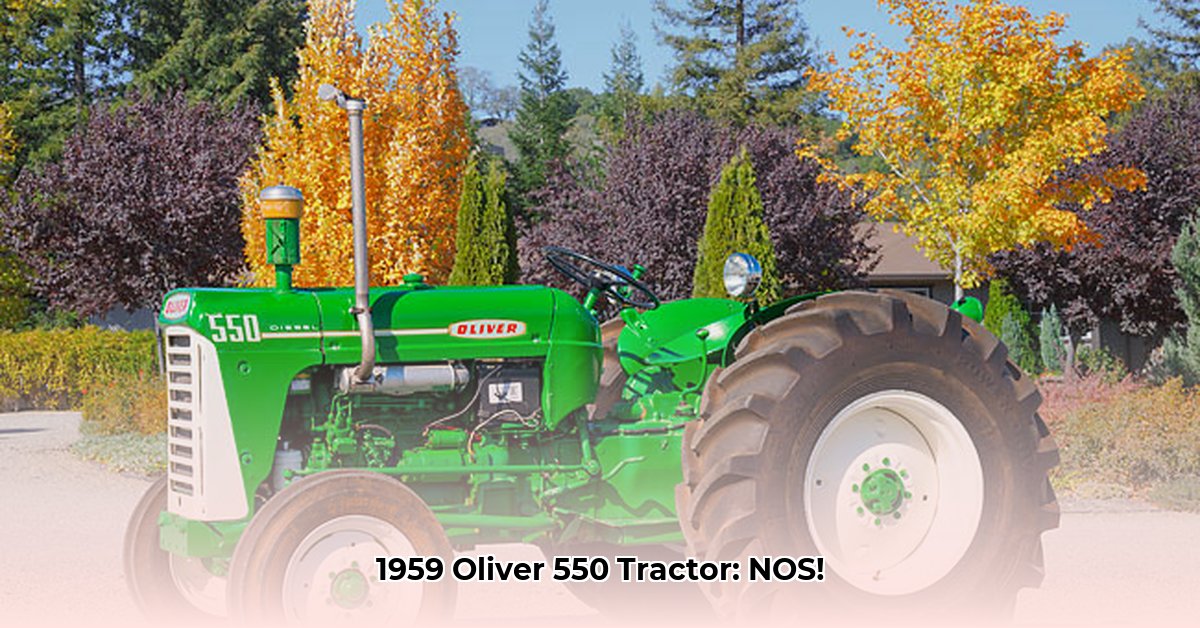
Finding a pristine, never-before-used 1959 Oliver 550 tractor—a true "New Old Stock" (NOS) find—is like discovering a time capsule. This rare machine represents a significant era in farming history, offering a unique blend of robust engineering and classic design. This guide explores everything you need to know about this exceptional piece of agricultural heritage, from its historical context and technical specifications to restoration, valuation, and practical applications today. For detailed maintenance guidance, see our guide on oil pan gasket replacement.
A Blast from the Past: The Oliver 550's Legacy
Oliver tractors hold a revered position in agricultural history. The 550, produced between 1958 and 1975, was a true workhorse, celebrated for its dependable performance and sturdy construction. While precise production figures remain elusive, the 550's popularity makes a NOS model an exceptionally rare find. Owning such a machine offers a unique opportunity for collectors and enthusiasts alike, a chance to own a piece of history virtually untouched by time. The 550's design embodies the technology and needs of its era; its smooth lines and sturdy frame are a testament to its time, representing more than just a machine—it was a symbol of progress and a vital part of rural life.
Under the Hood: Power, Performance, and Practical Considerations
The Oliver 550 delivered impressive power for its time. While sources show slight variations—likely due to minor model differences across its production run—it consistently provided approximately 41 horsepower at the power take-off (PTO) and around 35 horsepower at the drawbar. This power, channeled through a versatile 540/1000 RPM PTO system, enabled it to handle a wide range of tasks.
However, it's crucial to acknowledge technological advancements since 1959. Its hydraulic system, with a flow rate of 5.25 gallons per minute (gpm), is less powerful than modern tractors. This means certain tasks—particularly those involving heavy or fast-moving implements—might be slower or more demanding. Similarly, its smaller tires, while durable, may limit traction in wet or challenging conditions. Think of the 550 as a robust and reliable workhorse, best suited for lighter duties compared to its modern counterparts.
Key Specifications:
| Feature | Specification | Notes |
|---|---|---|
| Engine Type | Gasoline or Diesel | Varied based on year of manufacture. |
| PTO Horsepower | ~41 hp | Estimates based on various sources and owner reports. |
| Drawbar Horsepower | ~35 hp | Represents actual pulling power. |
| Hydraulic Pump Flow | 5.25 gpm | Considerably lower than modern tractors; impacts implement speed and power. |
| PTO Speed | 540/1000 RPM | Common for the era; adapters may be needed for some modern implements. |
Restoration and Maintenance: A Guide for the Dedicated
Restoring a NOS 1959 Oliver 550 is a rewarding but demanding project. Sourcing parts requires dedication; you'll likely need to network with fellow collectors, explore online forums, and attend vintage equipment auctions. Preventative maintenance is paramount. Regular inspections, meticulous attention to detail, and prompt addressing of issues (worn bearings, fuel system concerns, hydraulic leaks) are vital for preserving your investment and ensuring smooth operation.
Common Potential Issues:
- Fuel System: Age and fuel type can affect this crucial system.
- Hydraulic System: Seals may require replacement after years of inactivity.
- Seized Moving Parts: Long-term storage can lead to seized components.
A methodical, well-planned approach is crucial for successful restoration. A detailed restoration plan, including parts sourcing, budget allocation, and a timeline, would reduce stress and improve results.
Assessing Value and Authenticity: A Collector's Perspective
Determining the value of a NOS 1959 Oliver 550 depends significantly on its condition. A pristine, untouched example commands a premium price. Authenticating its originality is crucial. Look for matching serial numbers, original paint (or documented repainting), and genuine components. Professional appraisals are highly recommended before purchasing or selling to avoid inaccuracies.
Practical Applications for the Modern Hobby Farmer
While not as powerful as modern tractors, a restored 1959 Oliver 550 remains suitable for various tasks on smaller properties. It excels in jobs like mowing, tilling small plots, and light hauling. However, it's essential to carefully consider the costs: maintenance, parts, and potential repairs. Weighing the cost-benefit against modern equipment is crucial for informed decision-making.
Conclusion: More Than Just a Machine
Owning a NOS 1959 Oliver 550 is about more than just possessing a machine; it's about connecting with agricultural history. It's a tangible link to a simpler time, a testament to enduring engineering. This commitment requires dedication and care; you're not just an owner, you're a custodian, responsible for preserving a remarkable piece of history and agricultural innovation. The effort and expense reflect a deep appreciation for both the machine's legacy and the rich history it represents.